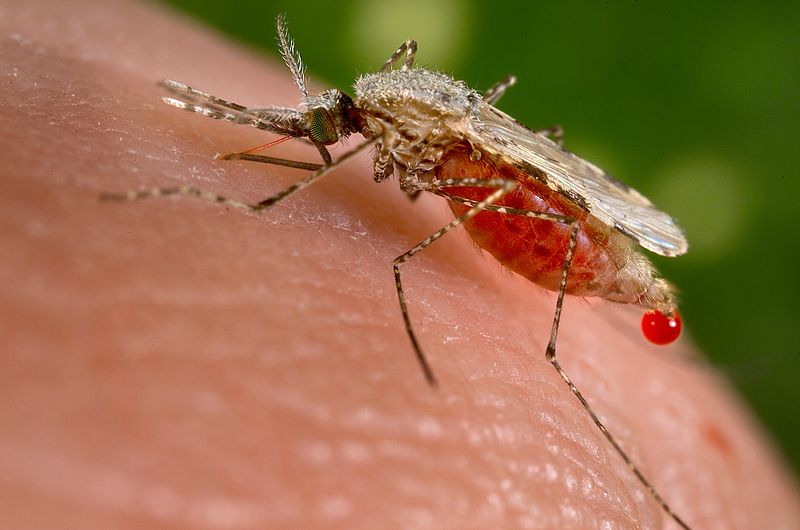VIIN focus on malaria
11 April 2017
Malaria researchers in the VIIN have published a number of excellent articles for 2017 already.
One high-impact study was led by VIIN researcher and Executive Member, Prof Tania de Koning-Ward from Deakin University. Published in eLife, the paper shows a new way to combat malaria.
“Malaria parasites live inside a red blood cell. They produce a group of proteins called the RhopH proteins to change the permeability of the red blood cell, making it more porous, so they can absorb vital nutrients from plasma, and remove toxic waste products,” Professor de Koning-Ward said.
“What we’ve shown is that if you genetically block one of these parasite proteins, you can effectively starve the parasite and it dies.”
Lead author Dr Natalie Counihan, a research fellow at Deakin’s School of Medicine, said the work was a crucial step in developing new drug targets.
“If you had a drug that blocked this protein then the parasite will die. Once you know what’s responsible for something you can start designing drugs to fight that,” Dr Counihan said.
The emergence of drug resistance in the malaria parasite, Plasmodium falciparum, poses a major threat to the control and elimination of malaria.


Photos: Prof Tania de Koning-Ward and Dr Darren Creek.
Dr Darren Creek’s team at the Monash Institute of Pharmaceutical Science have recently published their results identifying global biochemical differences between artemisinin –resistant and –sensitive strains of P. falciparum by combining LC-MS-based proteomics, peptidomics and metabolomics, with a focus on the propeller domain protein, PfKelch13. (Read the paper.)
Including first author Ghizal Siddiqui and Dr Anubhav Srivastava, the MIPS team found that PfKelch13 mutations associated with artemisinin resistance lead to decreased abundance of PfKelch13 protein, decreased haemoglobin digestion and enhanced glutathione production.
"These findings help us to understand how malaria parasites can bypass the effects of artemisinins," said Dr Creek. "The next step in our research is to see if these features are common to a range of artemisinin-resistant parasites in the field, so that these markers could be used to detect artemisinin resistance in patients.”
Another high-impact project to be published in recent months was led by VIIN researcher A/Prof Freya Fowkes at the Burnet Institute, and published in PNAS. This paper examines the possibility that naturally acquired immunity may confound estimations of anti-malarial resistance.


Photos: A/Prof Freya Fowkes and Dr Ricardo Ataide. Photo credits: Burnet Institute.
Dr Ricardo Ataide, first author of the study, said the study casts new light on the impact of malaria control activities, including the use of insecticide-treated bed nets. “These activities have helped to reduce the burden of malaria, which means that the level of immunity in populations living in those areas has also dropped.”
A/Prof Fowkes says, “If a person has low levels of immunity and is infected with artemisinin-resistant malaria, they will be very poor at clearing the drug-resistant parasites. However, the problem is that high levels of immunity in a population can make it appear as though the drug is working effectively, which has the effect of masking emerging drug resistance.”
“Because their immune system is making up the difference, we’re underestimating how much drug resistance there might be.”

Image: An Anopheles stephensi mosquito is obtaining a blood meal from a human host. From the Centers for Disease Control and Prevention's Public Health Image Library. This image is in the public domain and thus free of any copyright restrictions.
Other VIIN researchers with recent publications on malaria include:
- Dr Brad Sleebs, Prof Alan Cowman and first author Dr Wilson Wong, from Walter and Eliza Hall Institute with A/Prof Stuart Ralph from the Bio21 Institute and Department of Biochemistry and Molecular Biology, University of Melbourne. Published in Nature Microbiology or read the press release here. For the first time, this team has mapped how mefloquine, one of the longest-serving malaria drugs works. This opens the possibility of altering its structure to make it more effective and combat increasing malaria drug resistance.
- Dr Justin Boddey, Dr Sara Erickson and Ms Annie Yang from the Walter and Eliza Hall Institute. Published in Cell Reports or read the press release here. Dr Boddey’s team have identified proteins that enable malaria parasites to ‘walk through cell walls’. The project identified two proteins that are the key to the parasite’s ability to transverse liver cells. The proteins could be targeted to develop much-needed antimalarial drugs or vaccines.


Left: Dr Justin Boddey and Dr Sara Erickson. Right: Dr Brad Sleebs and Dr Wilson Wong. Photo credits: Walter and Eliza Hall Institute.
- Prof Alan Cowman’s laboratory at the Walter and Eliza Hall Institute have published two major studies in Elife. In one paper, Prof Cowman’s team examined invasion of erythrocytes by the malaria parasite, a complex process involving multiple ligand-receptor interactions. They showed that malaria protein, EBA-175 binds the host receptor glycophorin A to initiate a phosphorylation cascade resulting in changes in the viscoelastic properties of the host cell. Kinase inhibitors prevented merozoite invasion by directly inhibiting the phosphorylation cascade. In the second paper, Professor Cowman and team visualised the malaria vaccine candidate, CyRPA, at the atomic scale. Read the paper or the press release.
- Dr Alyssa Barry and her team, also from the Walter and Eliza Hall Institute. Published in the American Journal of Tropical Medicine and Hygiene. This study aimed to determine the complexity of infection and genetic diversity of Plasmodium vivax and P. falciparum throughout Papua New Guinea to evaluate transmission dynamics across the country.


Photos: Prof Stephen Rogerson and Dr Philippe Boeuf. Photo credits: University of Melbourne and Burnet Institute.
- Prof Stephen Rogerson and team from the University of Melbourne and Royal Melbourne Hospital. Published in Malaria Journal. Prof Rogerson conducted a clinical trial using Doppler ultrasound to examine the effects of malaria on uteroplacental and fetoplacental blood flow. His team identified that both microscopic and sub-microscopic P. falciparum infections impair fetoplacental and intrafetal flow, at least temporarily, and that that interventions to protect the fetus should clear and prevent both microscopic and sub-microscopic malarial infections.
- Dr Philippe Boeuf and team, from the Burnet Institute and University of Melbourne. Published in BMC Medicine. Dr Bouef’s study showed that inhibition of placental mTOR signaling provides a mechanistic link between malaria-associated intervillositis, a local inflammatory response of the placenta, and decreased amino acid uptake, which may contribute to lower birthweight in children born to mothers with malaria. Restoring placental mTOR signaling in placental malaria may increase birthweight and improve neonatal survival, representing a new potential therapeutic approach.
- Prof Magda Plebanski and team from Monash University have published two vaccine studies in Frontiers in Immunology and Nanomaterials (Basel).
These outstanding publications exemplify the strength and diversity of Victoria’s malaria research community. The critical mass of research talent, techniques and resources enables key questions in the field to be addressed. Malaria is a disease affecting some of the least developed regions of the world and Melbourne’s research community is making a vital contribution to reducing the burden of this infection, through a variety of new and innovative strategies to combat the malaria pathogen.
If there are other malaria papers we should be aware of, let us know.
To update your own VIIN profile, log in here: http://www.viin.org.au/ with the “SIGN-IN” box in the top right hand corner and retrieve your password.

